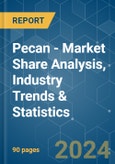The Pecan Market size is estimated at USD 2.34 billion in 2024, and is expected to reach USD 3.18 billion by 2029, growing at a CAGR of 6.33% during the forecast period (2024-2029).
This product will be delivered within 2 business days.
Key Highlights
- The pecan is a tree nut that is native to North America. Pecans are rich in dietary fibers and other nutrients such as manganese, phosphorous, and thiamin. They are also good sources of protein and vitamin B. Owing to these factors, the global production of pecans has increased over the last decade.
- North America dominates the market. The United States is the world's largest pecan-producing country. The United States and Mexico together accounted for more than 93% of the overall production in the world, while the rest was from countries like South Africa and Australia, among others. Other countries producing pecans include Australia, Brazil, Israel, Mexico, Peru, and South Africa.
- Moreover, the United States is not only a mere contributor to the pecan supply but also one of the world's major pecan consumers. For instance, in 2020, the country consumed nearly 68,344 metric tons of pecan, contributing to more than half of the global pecan supply for the same year.
- The increasing per capita spending on vegan foods, coupled with the increased nutritional awareness among various consumer groups, is driving the market for pecan across the globe. The demand for pecan has been growing around the world. For instance, in 2020, The Georgian Renaissance Group exported the first batch of pecan kernels to the European Union (Poland). Hence, the increased demand for pecan aids the market's growth in the forecast period.
Pecan Market Trends
Increased Health Benefits and Enough Supply is Driving the Consumption
- The pecan is usually referred to as a tree nut native to the North American region. Increasing consumer awareness regarding their health benefits and rising demand for plant-based food products. Pecans are a good source of calcium, magnesium, and potassium, which help lower blood pressure.
- Additionally, Pecan-based food products are increasing, as they have become one of the favored nuts among health-conscious consumers. For instance, pecan-based products such as pecan muffins, pecan biscuits, and many other pecan-based bakery products are becoming popular as a part of healthy diets. This is driving the consumption of pecans all over the globe.
- Along with this, the consumption of pecans is driven by the effortless supply. Farmers can sell the produced pecans in-shell or shell straight to consumers through farmers' markets and online websites for retail prices or to accumulators, wholesalers, and shellers for wholesale prices. This shows the flexibility in supply for the increased demand.
- Furthermore, the increased production leads to an increase in the supply of pecan nuts. The United States is the largest producer of pecans. For instance, according to the United States Department of Agriculture (USDA) 2023, pecan production went up from 2019 which is 255 million pounds to 274.5 million pounds 2022 with some ups and downs in between. The supply chain is also well established in the country, which leads to an increase in the supply, thereby leading to easy availability and a rise in consumption.
- Thus, the aforementioned reasons could result in higher potential pecan consumption over the forecast period.
North America Dominates the Global Pecan Market
- The United States is the leader in terms of the production of pecans. It contributes 80-90% of the world's pecan production. Over three-fourths of US, pecans were produced in Georgia, New Mexico, and Texas. According to the United States Department of Agriculture (USDA), the US pecan production for the 2020-21 marketing season amounted to 302 million pounds utilized in-shell basis, increasing from 255 million pounds in 2019.
- Along with the higher production, the United States is one of the world's largest pecan consumers. They include this nut in several of their quintessential recipes in the culinary arts. This is increasing consumption. Also, per consumption statistics released by the US Department of Agriculture, the per capita consumption of pecan settled at 0.6 kg per person per year in 2021. Despite the higher consumption trend, pecan production in the country was also termed high and peaked at 119,250 tons in 2019.
- Pecan nutmeat can be used in a variety of ways. This is increasing the consumption demand, which leads to an increase in the production of pecans. Fresh pecans have a slightly buttery taste and are an extremely healthy snack on their own or can be added to meals. Fresh pecans have the highest antioxidant content of all tree nuts. Shelled pecans are used in cakes, pies, pralines, and brittles.
- Furthermore, the increasing awareness of the nutrient composition of the pecan, especially its high dietary fiber and several other nutrients such as manganese, phosphorous, and thiamine, is spiking the demand from various consumer groups, especially vegan consumers. Also, relatively higher stocks of shelled pecans in the US cold storage shelves are likely to further translate into demand over the forecast period.
Additional Benefits:
- The market estimate (ME) sheet in Excel format
- 3 months of analyst support
This product will be delivered within 2 business days.
Table of Contents
1 INTRODUCTION
4 MARKET DYNAMICS
5 MARKET SEGMENTATION
Methodology

LOADING...










